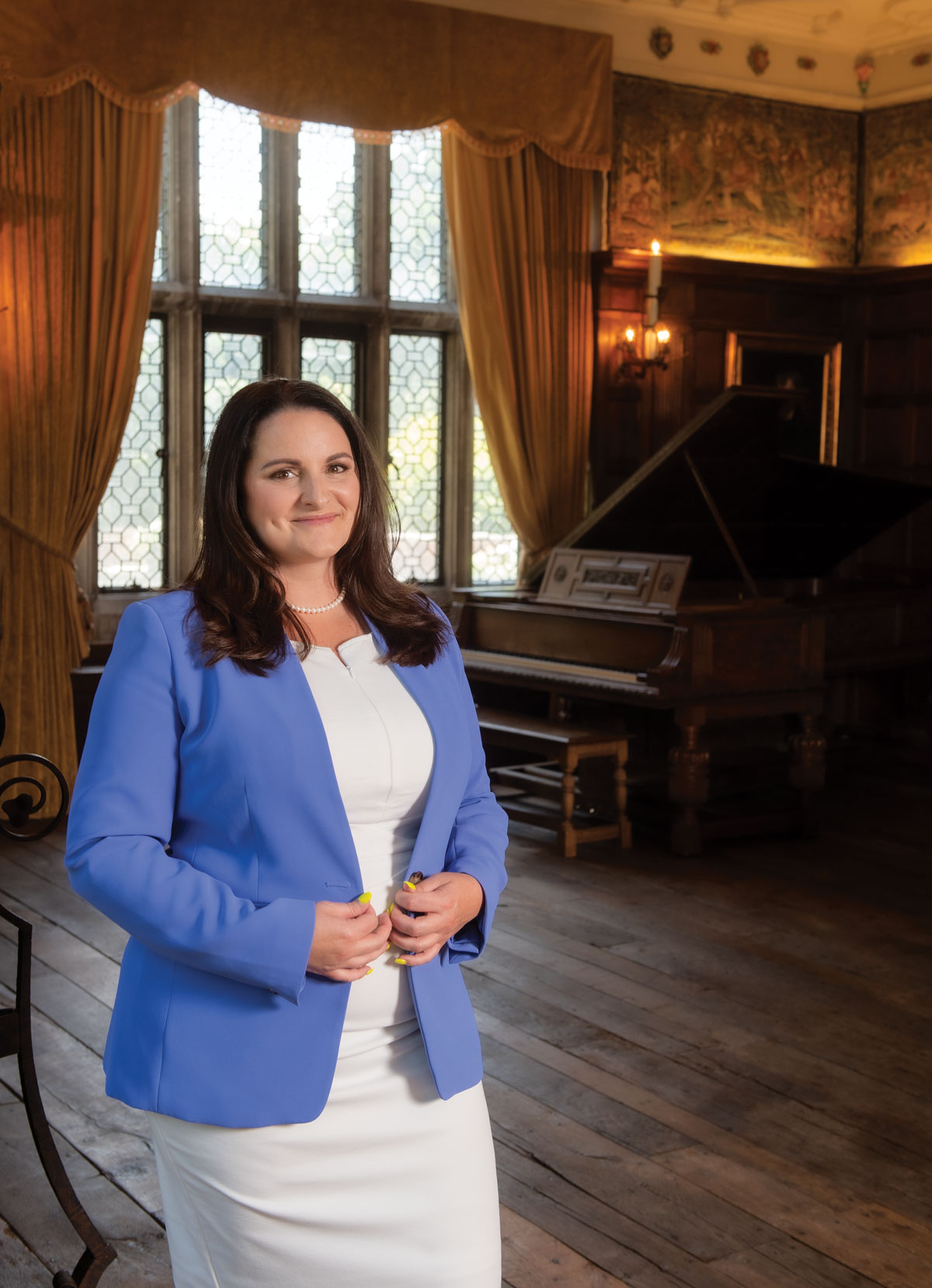A Closer Look: Keshia Meissner
Executive director, Salisbury House

Sarah Diehn Aug 8, 2025 | 6:00 am
10 min read time
2,488 wordsA Closer Look, All Latest News, Arts and CultureKeshia Meissner’s move to the Salisbury House five years ago was already a big switch after a career in health and human services nonprofits. Then, throw in the pandemic as well.
She started as executive director in June 2020 when the house was closed to the public and it was unclear when they could return to holding tours and events. Meissner, a northwest Iowa native, said despite being a big challenge to contend with early on, the closure gave her time to “pause and reflect.”
“It gave me a chance to figure out how things really worked around here and [gave] me some time to step back and look at things with a fresh perspective,” Meissner said. “When we were able to reopen, we already had several policies in place. We had already made several new hires. … We were able to do that because we weren’t open and so we were able to really be strategic and spend time as a team figuring out the challenges and planning for the future together.”
Before joining the Salisbury House, Meissner served as executive director of the Beacon for nearly nine years and worked for a domestic sexual assault center.
Five years into working for the Salisbury House, her day-to-day looks nothing like her first days on the job as she bounces between event planning and administrative tasks to overseeing maintenance of the 28,000-square-foot house and nine acres of woodland and gardens.
“One of the things I love most about my job is that no two days are alike. While that can be challenging, it is also exciting and there’s always a lot of momentum of movement and activity,” she said.
The historical home is also marking its centennial. The celebration began in 2023 and continues through 2028, to mirror the time it took to build Salisbury House 100 years ago. Meissner said a few events have been held so far, but the official kickoff will be the Gatsby Gala on Aug. 23, where the nonprofit aims to raise $100,000 for its endowment fund.
The fund is meant to be a sustainable funding source for the care and restoration of the building. Those interested in attending the gala can learn more at salisburyhouse.org/events.
We sat down with Meissner to discuss her path, the Salisbury House’s role in Des Moines arts and culture community and the nonprofit’s centennial celebration.
This Q&A has been lightly edited for clarity and length.
Working in health and human services nonprofits before this, what drew you to this role at the Salisbury House five years ago?
I think it was just wanting to have a new challenge. I had really loved my time in my prior organization and really felt connected to the mission but there also comes a point where you’re just ready for a different challenge. After being in health and human services for an extended period of time, I was looking for an opportunity to be involved in a different type of nonprofit organization. I love history and architecture, and so obviously, what better way to combine those two than the Salisbury House? We’re pretty lucky to have something like this here in Central Iowa. I really didn’t know about the Salisbury House for the first several years I lived here until I attended the Gatsby Gala in 2016. I got to walk around and I was just in awe of the space, and so I was immediately attracted to it.
Is there anything that drew you to nonprofit work specifically?
My mother has always been involved in some type of work environment related to people and helping others, and so I just saw that growing up. I’ve just always been really attracted to that type of work, and making a difference in our community I think is really important. Just always feeling fueled by that. My job here, specifically, may not help people, but it does bring awareness to the arts and cultural environment, the vibrant environment that we have here in Des Moines.
For those who may not know, can you share some of the history of the Salisbury House?
Salisbury House was built between 1923 and 1928, so we’re in the middle of our 100-year celebration. Carl and Edith Weeks were the builders of Salisbury House. Carl was an innovator and he was one of the original inventors of face foundation makeup, cold cream makeup. He established the Armand Company, which was headquartered here in Des Moines. It is now under the name Weeks & Leo and it’s in Clive. His company became a global conglomerate, and he had seven office locations around the world and over 45, 000 retailers. That’s how he made his money, and he and his wife were travelers and art collectors.
They were on a trip to England in 1920, and they traveled to Salisbury and while they were there, they toured a place called the King’s House, which is now a museum in Salisbury and fell in love with the architecture and the design of the building, so they chose to use that building as the model for Salisbury House. The footprint and the way that the building here looks on the outside is very identical to that structure. They worked with an antique dealer over in Salisbury to procure all of the items for the house and a lot of the artwork that you see in the house today. There’s a lot of architectural elements that are authentic pieces from various locations around Europe. In fact, three of the rooms in the house — the common room, the library and the dining room — come out of a building called 91 Crane Street, which was a structure in Salisbury. That paneling and flooring was removed from that structure and brought here to Salisbury House and incorporated in the design.
Do you have a favorite piece of history about the house or favorite thing you’ve learned since working here?
That’s a loaded question. The nice thing about working here is that we are constantly learning new things. Our archives are full of materials and things, so we’re constantly learning new things that happened during the building or while the family lived here. That’s something I really enjoy about this job is just getting to learn something new all the time. I don’t have one specific thing because there’s so many different, unique areas of the house and stories behind different pieces or artwork. One of the most notable things is the half-beam Tudor ceiling in our Great Hall, which came out of an inn in Salisbury and it is highly probable that Shakespeare performed under the rafters because he, along with King James I, stayed in the inn in the summer of 1603. Carl’s antique dealer in Salisbury had the opportunity to purchase it for Carl. And so Carl purchased that and it’s in the Great Hall today and gifted a section of that to his friend, Mr. Ralph Rollins from the Rollins Mansion.
What does it look like to maintain and preserve the house and the antiques inside?
Something that we are always thinking about is the restoration, maintenance and general care of not just the facility itself, but also the artwork and various pieces of furniture and tapestries that are under our care. Everything in the house is original to the family and their time here, so everything is at least 100 years old or older. In fact, the oldest piece in our collection dates back to 2500 BC. We are constantly putting together plans looking at different art pieces and what needs attention. The building itself, being almost 100 years old at this point, is something that we’re constantly keeping an eye on — the roof and everything from the historic gutters that were from Trafalgar Square in England, they date back to the 16th century. Several of the windows also date back to the 16th century, so you can’t call a company and say, ‘Can you come pop in a new window?’ There’s a lot more that goes into that.
How has the significance and role of the house changed over its 100 years?
Carl’s vision when he built the house was always to make sure that it went back to the community, or that it served the community later knowing that it wouldn’t be something that would probably stay in their family forever. It was more about providing the Des Moines area a structure that would be so unique and unlike anything else in the area that would serve the public. It gives us a really interesting building that we can use as a resource. Carl and Edith were both philanthropists and were heavily involved in the creation of several different organizations in town, including Civic Music Association and the Des Moines Art Center. They were involved on many different boards. Edith was one of the original members of the Des Moines Gardening Club and Carl served as District Governor of Rotary twice. They hosted several fundraising events here, and they were instrumental in bringing acts to town like Louis Armstrong and other notable artists and musicians.
Funds from the Gatsby Gala will be going to the Salisbury House’s endowment fund. Can you share the history of the endowment fund and how it works?
It was started when the Salisbury House was raising money to purchase the house from the Iowa Education Association back in the mid to late 90s, so it’s been there over time. Our goal with the Gatsby Gala is to highlight the sustainable fundraising efforts of our endowment fund as investment dividends from that account generate unrestricted revenue for us so that we can complete vital restoration projects and or increase staffing or other specialty projects that we have going on with the organization. The main purpose is for that restoration and maintenance to actually take care of the house. The income from the endowment is to support those efforts so the expense of the restoration and maintenance lessen the burden on our general fund.
The endowment is made up of general contributions, restricted gifts. If someone gives a restricted gift to the endowment, we’re not allowed to spend that. It stays in the endowment and generates money. All of the money in the endowment is invested so we’re allowed to use the dividends or the interest. Then what we earn off of it each year, we’re able to take that out and put it into these other projects. Essentially, a gift to the endowment fund is a gift that keeps on giving. Your gift will continue to give year over year.
The Salisbury House is currently raising money to replace its parking lot, can you talk a little bit about that project?
There’s always something that could be done or needs addressed at the Salisbury House structurally, so over the last several years, we have taken a project that needed to be done and used that as a small annual capital project. We’ve been able to replace things like the parking lot retaining wall and the main entrance point from the parking lot to the south garden with a new pathway, and most recently this year we have launched a four-year campaign to replace the paved surfaces and driveway areas of the building, including the parking lot. We’re almost done with our first zone, our first phase of the project, which was the north circle driveway and accessible parking. With this, we’ve been able to expand the area. Our goal is to be able to get buses and tour buses in more efficiently than they have been in the past.
What funding avenues other than the endowment fund support the Salisbury House?
One of the biggest revenue sources for us is serving as a rental venue for celebrations like weddings, engagement parties, birthdays and anniversary parties. By doing that, it allows us to generate unrestricted income that we can use for operations or maintenance, restoration, really whatever it is that we need to focus on. Over the last couple years, we’ve been able to add several positions because of that and grow our team.
What positions have you added?
An events associate, a museum manager and we’ve taken jobs that were part time and made them full time. And we added benefits. That’s important because when I started there weren’t a lot of benefits. At the moment, all of our staff are full-time employees now.
When you started at the Salisbury House, what were some of your visions and goals for what you wanted to accomplish?
For me, one of the biggest challenges we have is just the footprint of Salisbury House and how very little the community actually knows about Salisbury House. As I said, I didn’t know about it for several years, and it took me attending an event to realize ‘Oh my gosh, this is here in Central Iowa?’ One of my biggest goals is to continue to educate our community. We’ve seen a significant increase in visitors and event attendees over the last five years, and I think that we are starting to make some headway in bringing awareness of what Salisbury House actually is and the fact that we are an art museum. A lot of people don’t realize that we have art pieces by some of the same artists that you would find in some of the world’s most famous museums.
What are some of the accomplishments or projects you’ve been proud of in your five years in this role?
The last five years, we’ve undergone almost $1 million worth of restoration, renovation and upkeep to the building, including new fire and security systems, updates to our building mechanical systems and of course, a variety of different capital projects from limestone restoration and the other two capital projects I mentioned.
What are some opportunities or goals you’re looking toward in the future?
I think to continue our partnerships with different organizations and continue to share the significance of Salisbury House with not just our general public, but also our out-of-town guests. We’ve seen an increase in our guests visiting us from across the state, the country and globally. We’re pretty excited about that. We’ve launched our new website and put in a few other things that have allowed us to attract those visitors, so that’s something we’re really proud of. We do have a short list of capital projects that we’re wanting to look at, like restoration of the historic cottage, so we can put that back on tour or use it as a small rental space for smaller activities or events. That’s probably what we’re looking to accomplish after the parking lot project over the next couple of years.
At a glance
Hometown: Spencer, Iowa
Education: Bachelor’s degrees in psychology and human services from Buena Vista University
Hobbies: Traveling and new experiences
Contact: kmeissner@salisburyhouse.org

Sarah Diehn
Sarah Diehn is editor at Business Record. She covers innovation and entrepreneurship, manufacturing, insurance, and energy.









